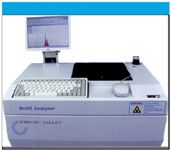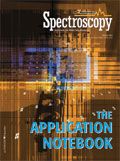RoHS Analyzer for Compliance with Environmental Regulations for Hazardous Substances
Jordan Valley AR, Inc.
Jordan Valley's RoHS Analyzer uses a powerful X-ray tube and a new generation high resolution Si PIN detector (see Table 1) to measure low levels of heavy metals, allowing electronics manufacturers to comply with new regulations designed to reduce environmental waste and adverse health effects.

The Restriction of Hazardous Substances Directive (RoHS), designed to restrict toxic metals in new electrical and electronic equipment, profoundly impacts the electronics industry. Producers must now document the levels of restricted substances in their equipment. RoHS restricts six substances — lead (Pb), mercury (Hg), cadmium (Cd), hexavalent chromium (Cr6+), and certain compounds of bromine (Br), PBB and PBDE. These elements occur in compounds which are commonly used as fillers, stabilizers, pigments, and flame retardants.

Table I. Features of Si PIN Diode, Si(Li), and Silicon Drift Detectors.
To be compliant, manufacturers must prove that these compounds fall below their maximum concentration values (MCV).
Jordan Valley's new RoHS Analyzer was specifically designed to help electronics manufacturers determine the precise level of restricted substances and certify that they fall below the MCV. This high-powered instrument provides fast quantitative analysis of lead in solder for Pb-free electronics requirements, and sorts chlorinated and/or brominated plastics. Highly reliable, accurate analytical results can be obtained in PE, PVC, or other polymers. In one easy step, the analyzer measures extremely low levels of Cr, Hg, Pb, Br, Cd, and other heavy metals and identifies PVC, Br- or Sb- or P-based flame retardants.

Figure 1. RoHS Analyzer.
The nondestructive energy-dispersive technique means that samples are left unaffected to allow further testing by the same or additional techniques for quality control purposes. Additionally, every step is fully documented with an audit trail for self-certification and compliance verification.
Jordan Valley is a leading designer, manufacturer, and marketer of energy-dispersive X-ray fluorescence (EDXRF) systems and components with more than 30 years' spectroscopic experience. We provide quality and cost-effective answers to real-world analytical challenges by melding the latest technological developments with innovative engineering.
Jordan Valley AR, Inc.
8601 Cross Park Dr., Suite 200, Austin, TX 78754
Tel . (877) 777-1222, Fax (512) 973-9282

Thermo Fisher Scientists Highlight the Latest Advances in Process Monitoring with Raman Spectroscopy
April 1st 2025In this exclusive Spectroscopy interview, John Richmond and Tom Dearing of Thermo Fisher Scientific discuss the company’s Raman technology and the latest trends for process monitoring across various applications.
A Seamless Trace Elemental Analysis Prescription for Quality Pharmaceuticals
March 31st 2025Quality assurance and quality control (QA/QC) are essential in pharmaceutical manufacturing to ensure compliance with standards like United States Pharmacopoeia <232> and ICH Q3D, as well as FDA regulations. Reliable and user-friendly testing solutions help QA/QC labs deliver precise trace elemental analyses while meeting throughput demands and data security requirements.